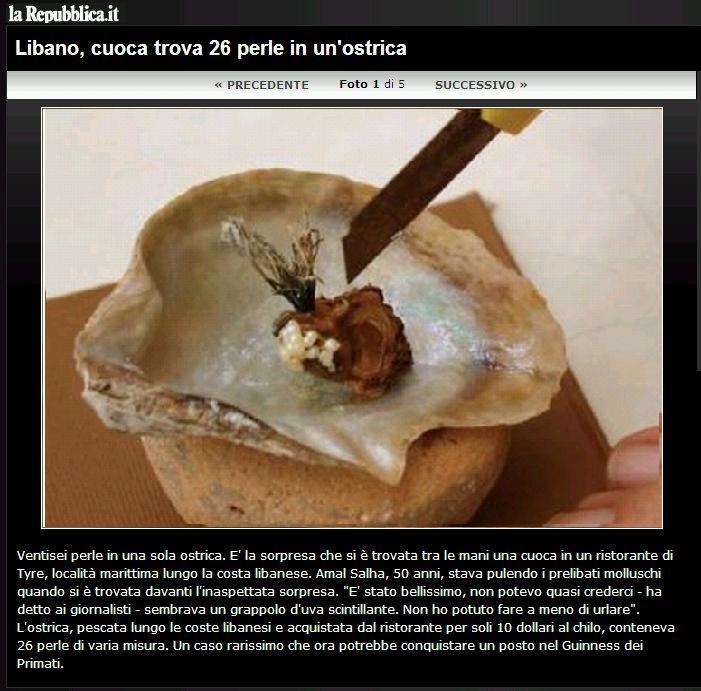
Argonauta 7-12 2011
 |
 |
ConclusioniHo iniziato una mia indagine nel tentativo di comprendere se il mio ritrovamento fosse un evento eccezionale o meno e vi propongo quindi alcune mie....ConsiderazioniSu internet, si legge, tradotto in tutte le lingue principali: "Le perle naturali o perle fini, sono estremamente rare. In natura, solo una su 10.000 ostriche produrrà una perla. Di queste, solo una piccola percentuale raggiungerà la dimensione, la forma e il colore di una gemma desiderabile. Le probabilità di trovare una perla naturale perfetta sono circa una su un milione. A causa della loro rarità, le perle naturali non si trovano quasi mai nella maggior parte dei negozi di gioielli. La maggior parte delle perle per la vendita nel mercato di oggi sono perle coltivate". Testo tratto da:http://www.pearlhours.com/index.php?natural-pearls-cutltured-pearls.html. Al di la dell’enfasi e dell’attendibilità di tali stime e percentuali, magari funzionali ad incrementare il valore delle perle naturali, non penso vi siano dubbi sul fatto che il loro ritrovamento sia un caso piuttosto raro. Nella mia ricerca, durata mesi, ho trovato la notizia del ritrovamento di un’ostrica con 150 perle nel celebre libro di Jules Verne "20.000 leghe sotto i mari", nell’edizione inglese. Lo stesso capitan Nemo sembra avere però dei dubbi. Sapendo che spesso Verne riportava notizie di pubblicazioni scientifiche, ho cercato ancora ed ho trovato una traduzione pedestre in italiano sul GIORNALE DI FISICA, CHIMICA E STORIA NATURALE; I BIMESTRE DEL 1809. In essa si dice che se ne sono vedute fino a centocinquanta nella medesima ostrica, ma non viene riportato nulla sul suo ritrovamento e non c’ è nemmeno un disegno dell’esemplare. Ho trovato, invece, una notizia più recente, in tutte le lingue principali e pubblicata tra gli altri sulle pagine on-line dei quotidiani The Telegraph, Le Figaro, El Pais, Il Corriere della Sera e La Repubblica (http://www.repubblica.it/2006/12/gallerie/ambiente/ostrica-record/1.html), sul ritrovamento a Tyro in Libano nel 2008, da parte di una certa Amale Salha, di una Pinctada con 26 perle. A tale proposito, si parla di valore inestimabile e di inserimento nel libro dei Records Guinness; in seguito, però, non si sono più avute notizie; il reperto sembra sia ancora nel ristorante dove è stato trovato, e non è stato inserito nel Guinness dei primati. |
ConclusionI started my research in an attempt to understand whether my discover was an exceptional event or not, and will therefore propose that some of my ....ConsiderationsOn the internet, it says, translated into all major languages:"The natural pearls or fine pearls are extremely rare. In nature, only one in 10,000 oysters produce a pearl. Of these, only a small percentage will reach the size, shape and the color of a gem desirable. The chances of finding a perfect natural pearl are about one in a million. Because of their rarity, natural pearls are not rarely in most jewelry stores. Most of the pearls for sale in the market today are cultured pearls. " Text taken from: http://www.pearlhours.com/index.php?natural-pearls-cutltured-pearls.html. Beyond the emphasis and reliability of these estimates and percentages, perhaps to increase the functional value of natural pearls, I do not think there is any doubt about the fact that their occurrence is rare to find. In my research, lasted for months, I found the news of the discovery of an oyster pearls with 150 in the famous book by Jules Verne's "20,000 Leagues Under the Sea", in the English edition. Captain Nemo seems to have the same doubts, however. Knowing that Verne is often reported news of scientific publications, I tried again and I found a pedestrian translation in Italian on the JOURNAL OF PHYSICS, CHEMISTRY AND NATURAL HISTORY, THE TWO MONTHS OF 1809. In it they say that they have the same views as far as ninety miles an oyster, but is not mentioned anything about his discovery, and there 'is not even a drawing of the specimen. I found, instead, the latest news in all major languages and published among others on the online pages of The Telegraph newspaper, Le Figaro, El Pais, Corriere della Sera and La Repubblica (http://www.repubblica.it/2006/12/gallerie/ambiente/ostrica-record/1.html), the discovery in Tyro in Lebanon in 2008, by some Salha Amalie, of a Pinctada with 26 pearls. In this regard, it is called priceless and inclusion in the Guinness Book of Records, and later, however, not been heard, the finding seems to be still in the restaurant where he was found, and was not included in the Guinness Book of primates. |

